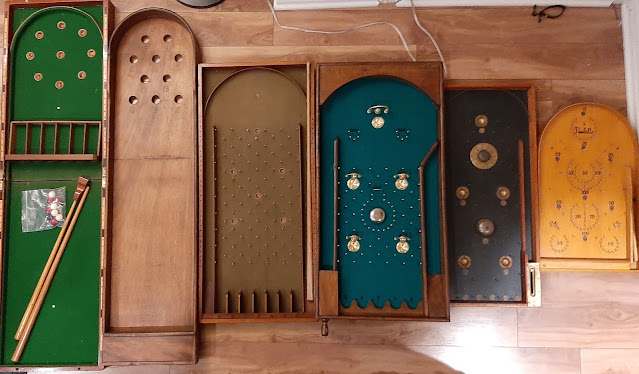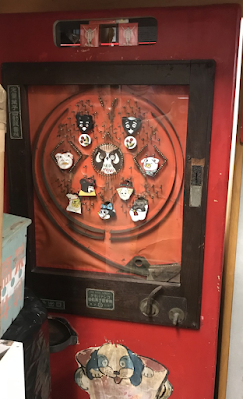2: Japanese Rolling Ball / Tamakorogashi (Japan)
3: Cockamaroo / French bagatelle (UK)
4: French bagatelle (France)
5: Singer parlor bagatelle (USA)
6: Poolette bagatelle (Japan)
How did we get here?
Well before all of these you'd find the early billiards variants, including trou madam. On table (1) there lies a set of wooden gates, allowing one to play trou madam and similar games on that table. English bagatelle, with the inlaid cups, seems to have sprung up early 1800s.
In the 1870s there is evidence of tables like (1) being made with holes in parallel rows, akin to (2). I think these tables were the inspiration for Japanese Rolling Ball, which came up around 1880 in Japan, 1902 in USA + Canada, and then about 1930 within Europe.
If you note the bottom scoring slots in table (3), you'll they're quite similar to the wooden gates available on (1). A key innovation would be taking a trou madam table and putting it on an incline. Shoot the balls up, and have them fall down in to the separated scoring arches. I am currently unsure if that innovation predates English Bagatelle (1) but it also seems like the kind of innovation that could have happened at in a number of eras and in a number of different areas.
It can be easy enough to infer how the cups of (1) migrated along the playfield of (3), the pigeon hole arches going to the bottom, and then pins added as obstacles.
Table (4) adds a spring plunger on one side, and maintains a cue lane on the right-hand side. Table (4) also has arches, which were an accessory to some billiards games going back to the 17th century at least, but were perhaps an innovation that was once again fresh at the time. Bells are also a new addition.
Table (5) does away with the cue altogether, relying exclusively on a spring plunger.
Table (6) is an example of how for some games the cue was kept instead of a spring plunger.






